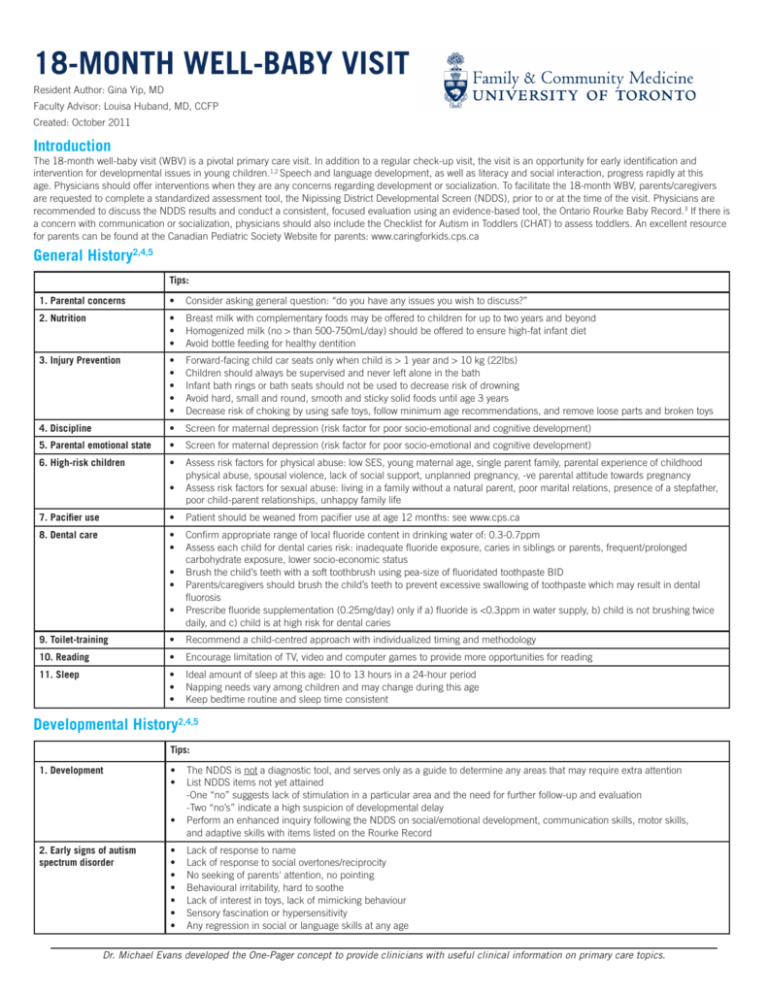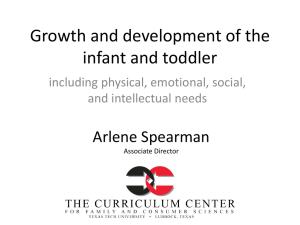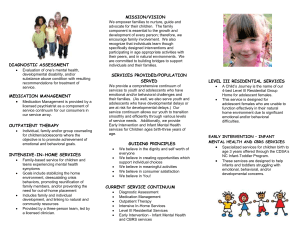18-month well-baby visit
advertisement

18-MONTH WELL-BABY VISIT Resident Author: Gina Yip, MD Faculty Advisor: Louisa Huband, MD, CCFP Created: October 2011 Introduction The 18-month well-baby visit (WBV) is a pivotal primary care visit. In addition to a regular check-up visit, the visit is an opportunity for early identification and intervention for developmental issues in young children.1,2 Speech and language development, as well as literacy and social interaction, progress rapidly at this age. Physicians should offer interventions when they are any concerns regarding development or socialization. To facilitate the 18-month WBV, parents/caregivers are requested to complete a standardized assessment tool, the Nipissing District Developmental Screen (NDDS), prior to or at the time of the visit. Physicians are recommended to discuss the NDDS results and conduct a consistent, focused evaluation using an evidence-based tool, the Ontario Rourke Baby Record.3 If there is a concern with communication or socialization, physicians should also include the Checklist for Autism in Toddlers (CHAT) to assess toddlers. An excellent resource for parents can be found at the Canadian Pediatric Society Website for parents: www.caringforkids.cps.ca General History2,4,5 Tips: 1. Parental concerns • Consider asking general question: “do you have any issues you wish to discuss?” 2. Nutrition • Breast milk with complementary foods may be offered to children for up to two years and beyond • Homogenized milk (no > than 500-750mL/day) should be offered to ensure high-fat infant diet • Avoid bottle feeding for healthy dentition 3. Injury Prevention • • • • • 4. Discipline • Screen for maternal depression (risk factor for poor socio-emotional and cognitive development) 5. Parental emotional state • Screen for maternal depression (risk factor for poor socio-emotional and cognitive development) 6. High-risk children • • 7. Pacifier use • Patient should be weaned from pacifier use at age 12 months: see www.cps.ca 8. Dental care • • • • • 9. Toilet-training • Recommend a child-centred approach with individualized timing and methodology 10. Reading • Encourage limitation of TV, video and computer games to provide more opportunities for reading 11. Sleep • Ideal amount of sleep at this age: 10 to 13 hours in a 24-hour period • Napping needs vary among children and may change during this age • Keep bedtime routine and sleep time consistent Forward-facing child car seats only when child is > 1 year and > 10 kg (22lbs) Children should always be supervised and never left alone in the bath Infant bath rings or bath seats should not be used to decrease risk of drowning Avoid hard, small and round, smooth and sticky solid foods until age 3 years Decrease risk of choking by using safe toys, follow minimum age recommendations, and remove loose parts and broken toys Assess risk factors for physical abuse: low SES, young maternal age, single parent family, parental experience of childhood physical abuse, spousal violence, lack of social support, unplanned pregnancy, -ve parental attitude towards pregnancy Assess risk factors for sexual abuse: living in a family without a natural parent, poor marital relations, presence of a stepfather, poor child-parent relationships, unhappy family life Confirm appropriate range of local fluoride content in drinking water of: 0.3-0.7ppm Assess each child for dental caries risk: inadequate fluoride exposure, caries in siblings or parents, frequent/prolonged carbohydrate exposure, lower socio-economic status Brush the child’s teeth with a soft toothbrush using pea-size of fluoridated toothpaste BID Parents/caregivers should brush the child’s teeth to prevent excessive swallowing of toothpaste which may result in dental fluorosis Prescribe fluoride supplementation (0.25mg/day) only if a) fluoride is <0.3ppm in water supply, b) child is not brushing twice daily, and c) child is at high risk for dental caries Developmental History2,4,5 Tips: 1. Development • • • The NDDS is not a diagnostic tool, and serves only as a guide to determine any areas that may require extra attention List NDDS items not yet attained -One “no” suggests lack of stimulation in a particular area and the need for further follow-up and evaluation -Two “no’s” indicate a high suspicion of developmental delay Perform an enhanced inquiry following the NDDS on social/emotional development, communication skills, motor skills, and adaptive skills with items listed on the Rourke Record 2. Early signs of autism spectrum disorder • • • • • • • Lack of response to name Lack of response to social overtones/reciprocity No seeking of parents' attention, no pointing Behavioural irritability, hard to soothe Lack of interest in toys, lack of mimicking behaviour Sensory fascination or hypersensitivity Any regression in social or language skills at any age Dr. Michael Evans developed the One-Pager concept to provide clinicians with useful clinical information on primary care topics. 18-MONTH WELL-BABY VISIT Physical Examination2,4,5 Items: Tips: 1. Height • Improve accuracy by: • Measure twice, record results immediately, calculate exact age, and plotting findings on the chart 2. Weight 3. Head circ. 4. Fontanelles • Fontanelles should be closed 5. Red reflex • Absence of red reflex may be caused by retinoblastoma or cataract • Refer for complete visual screening if testing is abnormal 6. Corneal light reflex / cover- uncover test • Abnormal results may indicate amblyopia • Refer for complete visual screening if testing is abnormal 7. Hearing inquiry • Refer positive parental concern of hearing loss for formal hearing assessment • Refer all children with normal newborn hearing screening who are at high risk of hearing loss for formal audiology/infant hearing assessment 8. Teeth • Lift the lip for inspection of the teeth for dental caries (white spots or lines on tooth surface are early signs of tooth decay) • Upper teeth: central incisors, lateral incisors, ±first molars, ± canines • Lower teeth: central incisors, lateral incisors, first molars, ± canines Management Considerations A) Developmental Concerns1,4 Developmental Concern: Referral: Speech and language delay/difficulty only • Preschool Speech and Language Program • Infant Development Program • Or continue to monitor closely as needed Symptoms of social difficulty/autism • CHAT screening tool • Refer for paediatric assessment • Preschool Speech and Language Program • Infant Development Program • Preschool Autism Services • Or continue to monitor closely as needed Delay with motor development + global developmental delay • Paediatric assessment • Developmental Paediatrician • Infant Development Program • Children’s Treatment Centre • Healthy Babies Healthy Children Social/emotional parent and family issues • Children’s Mental Health Services • Healthy Babies Healthy Children • Infant Development Program B) Immunization6 1. DTap-IPV-Hib (diphtheria, tetanus, and acellular pertussis vaccine, inactivated poliovirus vaccine, Haemophilus influenza type b vaccine) – Pediacel®/ Pentacel® 2. Verify all other previous vaccinations are up to date Resources for Parents and Physicians 18-month well-baby visit web portal http://public.machealth.ca/programs/18-month/default.aspx 18 Month Visit Flowchart http://www.ocfp.on.ca/docs/cme/18-month-well-baby-visit-flow-sheet. pdf Nipissing District Developmental ScreenTM www.ndds.ca Rourke Baby Record www.rourkebabyrecord.ca www.cfpc.ca Ontario College of Family Physicians www.ocfp.on.ca Canadian Paediatric Society For physicians: www.cps.ca For parents/caregivers: http://www.caringforkids.cps.ca/ Ontario Early Years Centres www.ontario.ca/earlyyears Ministry of Children and Youth Services www.ontario.ca/child Ministry of Health Promotion www.ontario.ca/mhp Ministry of Health and Long-term Care www.ontario.ca/health References can be found online at http://www.dfcm.utoronto.ca/programs/postgraduateprograme/One_Pager_Project_References.htm







